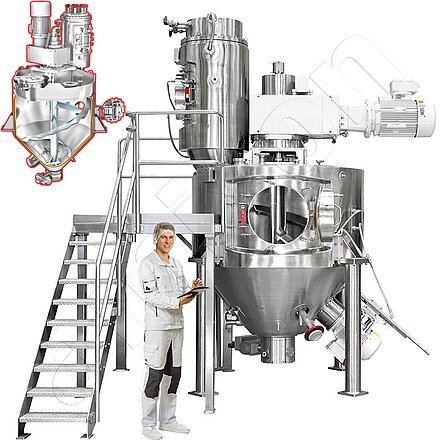Aseptic
"Aseptic" in the context of bulk mixing and bulk processing refers to aseptic treatment: Working under aseptic conditions and manufacturing sterile products. This applies to pharmaceutical liquid additives, but also to substance syntheses and solid galenics, as well as to bioreactors.
Fermenters in which bacterial cultures are grown and processed, for example, are subject to similar aseptic requirements. High-purity nutrients are also produced under sterile-like conditions. In practice, there are gradations from "strictly sterile" to "sterile-like". Filling a sterile mixer and discharging it is often done using isolators with integrated product handling.
If sterile powders must be prepared or mixed, the mixing operation must take place in a germ-free - aseptic - environment. The mixer/mixing unit must be sterilized in advance. This can be done either by using suitable liquid chemicals, or it can be carried out in the form of steam sterilization.

The requirement for steam sterilization is that all parts of the mixer/plant that come into contact with the product are heated to at least 135 °C for a defined period of time and that demineralized, sterile steam is introduced. The hot steam possesses high heat capacity and can effectively kill microorganisms. If the water vapor temperature is selected higher, then the holding time can be defined correspondingly shorter. As a rule, the sterile system/sterile mixer is designed to be gas-tight and pressure-tight up to a pressure of at least 3.5 bar gauge. If the temperature of the water vapor needs to be higher than 135°C, then the apparatus must withstand a higher pressure. If the process chamber of the sterile mixer may be loaded with an internal pressure of 4.5 bar, the water vapor can reach a temperature of 145°C.
All parts that come into contact with the product must be dried before the powder mixing process can start. Hot water is discharged downwards. The water vapor is removed by applying a vacuum. After the washing process, the mixer is usually cooled down before the powder mixing process or the vacuum contact drying operation under aseptic conditions is started.
An amixon® mixer-dryer reactor can also be used to sterilize powdery goods, for example high-purity plastics or plastic additives, spices, substrates for mushrooms, etc. In industrial practice, this method is used to pasteurize nutrient components or sterilize penicillin powder.
When a mixing plant is filled or emptied, air or gas exchange takes place. Escaping powder causes the plant to "inhale", and inflowing powder causes the plant to "exhale". Our ambient air is always contaminated with germs. In this respect, sterile filtration of the air must take place. In practice, this is done by supplying the production room concerned with sterile air or by installing a sterile dust filter above the mixer.
